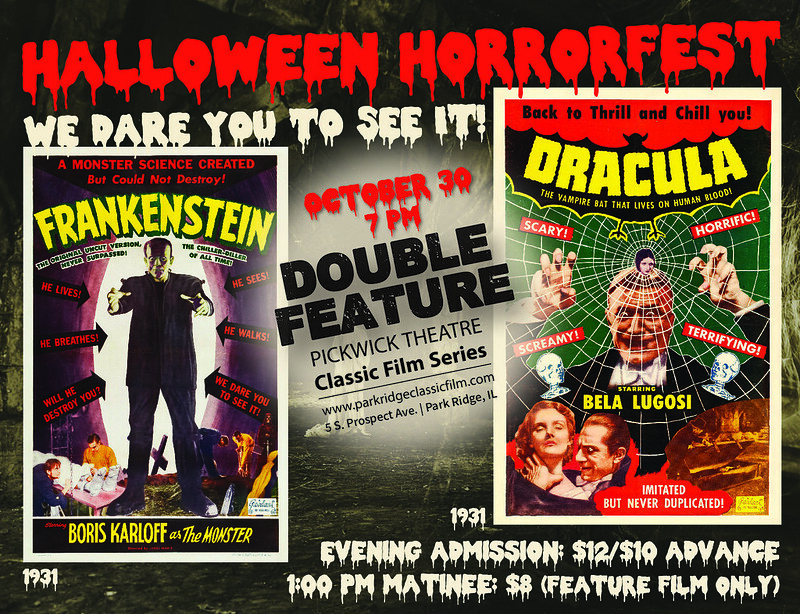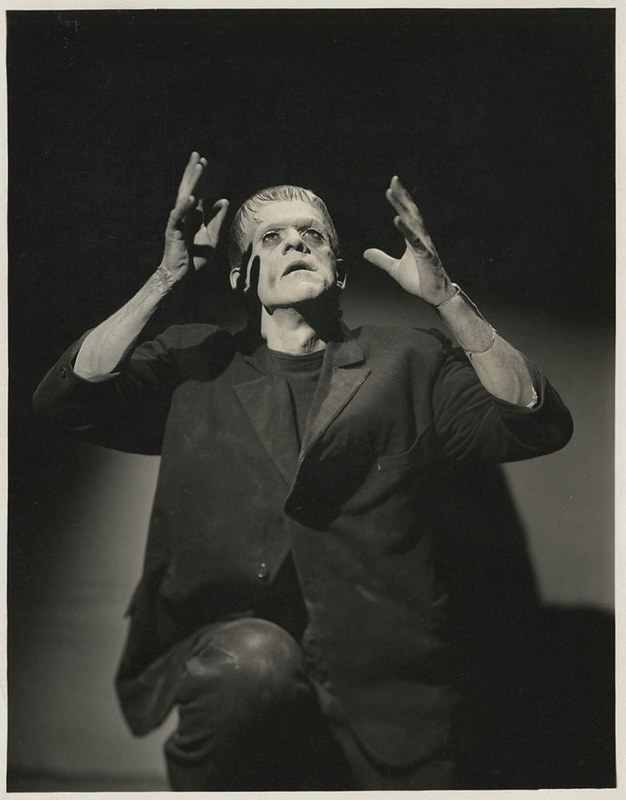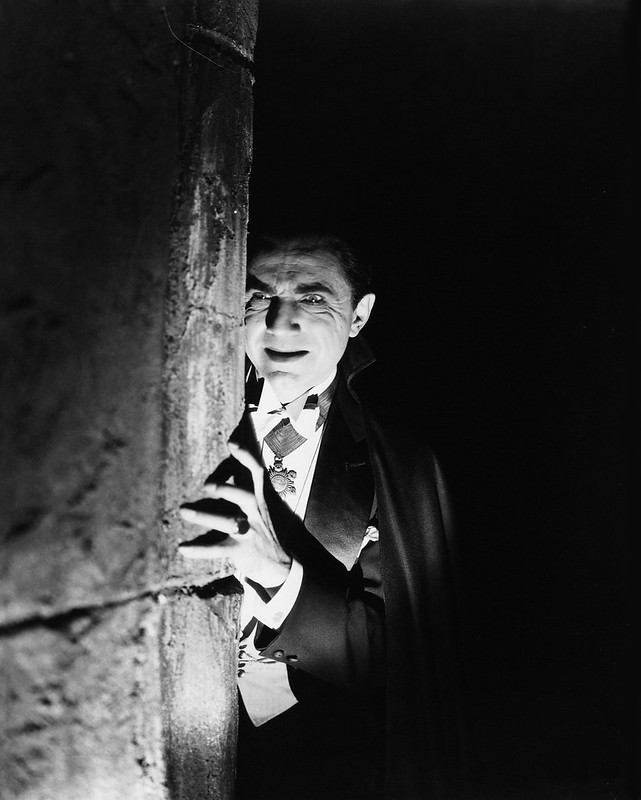WHAT: Frankenstein (1931) & Dracula (1931) Double Feature! (Presented in DCP.)
WHEN: October 30, 2019 1 PM & 7 PM
WHERE: Pickwick Theatre, Park Ridge, IL
HOW MUCH: $12/$10 advance or $8 for the 1 PM matinee. For advance tickets, Click Here!
NOTE: There will be a 10-minute intermission after the Frankenstein screening.

“For one who has not lived even a single lifetime, you’re a wise man, Van Helsing.” ~Count Dracula (Bela Lugosi) in Dracula
It’s the greatest double feature we’ll ever show at the Pickwick Theatre Classic Film Series. Join us on Wednesday, October 30, when we present our seventh annual Halloween Horrorfest. This year we will be offering two of the genre-defining classics released by Universal in 1931. Although Dracula debuted first, we will open with the original Frankenstein.
The Frankenstein films are the most enduring monster series of all-time with the first three being “four star” classics. Though we worked backwards to achieve it– having screened Bride of Frankenstein (1935) last season with special guest Sara Karloff– we will be completing the trilogy this Halloween. Directed by James Whale, who created a visual design heavily influenced by German Expressionism, Frankenstein (1931) was a breakthrough film in the genre for both the director and the unbilled actor playing The Monster. Despite his anonymity in the opening titles, Boris Karloff would almost immediately surpass Bela Lugosi as the preeminent star of horror in the 1930s. This will not be the last time we see the name KARLOFF at the Pickwick Theatre Classic Film Series, but it will be the last time we see him as the Frankenstein Monster.
Boris Karloff gave one of his finest performances in the original film. He brought both menace and pathos to the character of the Monster. As a result of his great artistry as an actor, there are many affecting moments that remain with us nearly ninety years later. Audiences remember scenes like the newly reborn Monster reaching up towards the heavens and trying to grab hold of the light– or the lakeside scene with the tragic Little Maria, whom the Monster innocently saw as a flower. This was the performance that made Boris Karloff a legend in the horror genre.
Boris Karloff as the Frankenstein Monster. (Make-up by the legendary Jack Pierce.)

After an intermission following our first feature, we will screen the original Dracula with Bela Lugosi. The film was made by Tod Browning, a director who, throughout the 1920s, specialized in macabre stories about outsiders. Less cinematically dynamic than Frankenstein, Dracula nevertheless has a power all its own. Based more on the English and American plays than on Bram Stoker’s 1897 novel, Dracula is more stage-bound and requires a special temperament to view it– one not trained by the visual overload of modern horror. Its Victorian, drawing room trappings aside, this is the ultimate vampire film every kid should see. Some call it “slow.” Others see it as a “slow-motion dream” whose silences and pace create an otherworldliness.
Through modern analysis, the flaws of Dracula have been documented and perhaps magnified. This was, after all, the early days of sound motion pictures. But despite this criticism, the 1931 film contains one of the most atmospheric opening reels in the genre as well as the greatest of all screen Counts. Some fans prefer the 1931 Spanish-language film– shot concurrently with the English version on the same Universal sets– but I’m not one of them. I’m well-versed in the foreign version, having discovered it in the early 1990s when it first surfaced. In fact, I had my high school Spanish teacher play it for us in class when I was a Senior. Granted, there is more at work cinematically with several eerie touches. I remember the mysterious fire burning at night during Renfield’s carriage ride through the Borgo Pass, and that shot of Dracula’s brides in the background waiting to pounce once Renfield collapsed. And the sensual Lupita Tovar as Eva is certainly a vast improvement over Helen Chandler’s strait-laced Mina in the English version.
However, the rest of the cast in the Spanish version is lacking. The worst culprit is Carlos Villarias as Dracula. He goes out of his way to evoke horror through broad facial expressions but only comes across as laughably inept. Lupita Tovar, reflecting perhaps a biased sensibility, once said that the only difference between Villarias and Lugosi was in the fingers– that Carlos had shorter fingers. Well, there was more to it than that. In a film built around the Dracula character– the central figure of the movie!– its hard to justify it being superior to the English version. Even visually, there are moments in Tod Browning’s film that are unmatched. Take a look at Bela Lugosi’s first dramatic appearance onscreen (and note the background elements)– or watch cinematographer Karl Freund’s crane shot through Dr. Seward’s sanitarium yard– appropriated for the Spanish version but flawed by a jump cut to Pablo Alvarez Rubio’s (Renfield’s) room.
Bela Lugosi as Count Dracula. His interpretation defined the role for all time.

Bela Lugosi, who became forever identified with the part, is such a commanding presence in the version we all know. He has a hypnotic power that is fascinating to behold. His confrontation with Val Helsing– and their battle of wills– is one of the film’s memorable moments. Edward Van Sloan , who had played Van Helsing opposite Lugosi on Broadway, was Universal’s resident “man of science”– the fatherly figure who knew all about those things best kept in the dark. He played Dr. Waldman in Frankenstein as well as Dr. Muller in The Mummy (1932).
As Renfield, the solicitor who becomes Dracula’s slave, Dwight Frye gives perhaps the most varied performance in the film. In many ways, his fate in Dracula paralleled his own career. Frye was an excellent actor trained on the New York stage. Like Renfield, Frye was a stranger in a new land, having recently come to Hollywood in the late 1920s. However, after Dracula, which gave him his first substantial part, Frye was typecast as madmen. In effect, he went crazy in Dracula and stayed that way in the public’s imagination. There were many exceptions, of course, such as his role as a young doctor who suspects Erich von Stroheim of foul play in The Crime of Dr. Crespi (1935), but Frye is generally remembered for his offbeat characterizations. Later in 1931, director James Whale cast Frye as Frankenstein’s hunchback assistant, Fritz.
On a personal note, I’m excited to be presenting the films that I grew up with thanks to influences like horror host “Svengoolie.” The current generation of Millenials will now have an opportunity to see them in a theatre in pristine, DCP restorations courtesy of Universal Studios. These are the films that have survived the test of time. In recent years, Universal tried to re-start its “Dark Universe” with reinterpretations of their famous monsters. To no one’s surprise, these attempts failed. The original classics, like Dracula himself, have an undying power that will last through the centuries to come. Over the last several years, teen vampire movies and television shows had become all the rage, but when the Twilight movies and its ilk have emulsified into dim memories, the world will still remember the 1931 Dracula. As Lugosi himself once stated, “Dracula never ends.”
Over the decades, generations have grown up with these classic films and their memorable characters. The “monster kids” of an earlier day remember the theatrical reissues of Dracula and Frankenstein and all the double features. Then came the monster magazines and monster horror hosts, and so on until this day when the films are still repackaged into “Legacy” collections. The merchandise is ever-flowing online, and the popularity remains undying. The story behind these films is constantly being retold and updated. For the definitive histories of these two beautiful works of horror folklore, we recommend the late Rudy Behlmer’s excellent commentary track on the Frankenstein dvd (as well as Gregory Mank’s definitive It’s Alive! The Classic Cinema Saga of Frankenstein) and David J. Skal’s Hollywood Gothic: The Tangled Web of Dracula from Novel to Stage to Screen. If you want to understand the history of Universal horror, start with these authors. It’s the ideal introduction to our screenings.
~MCH